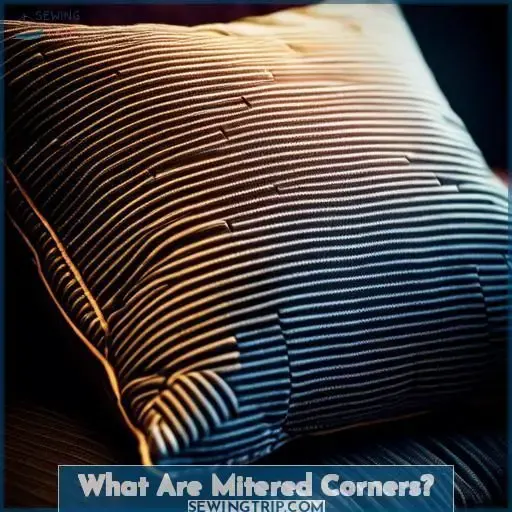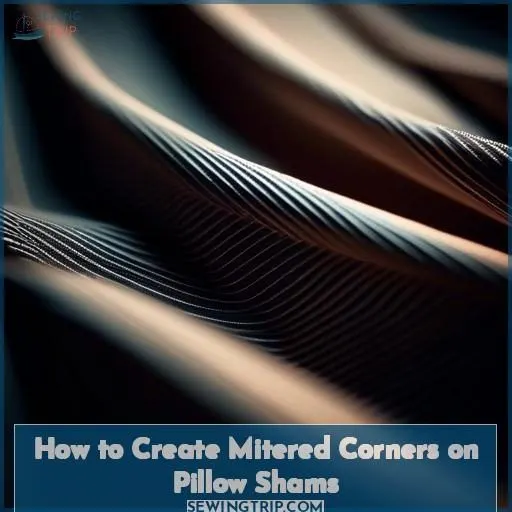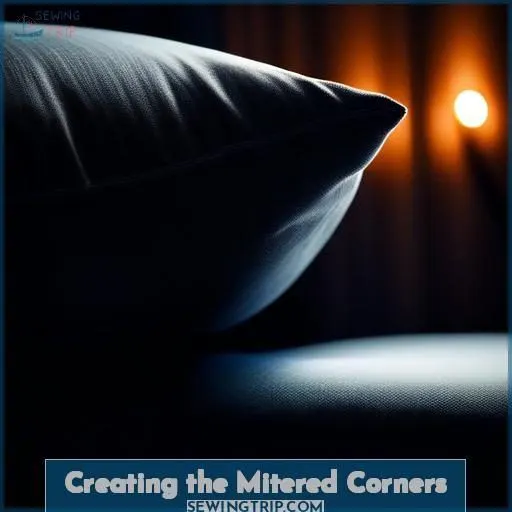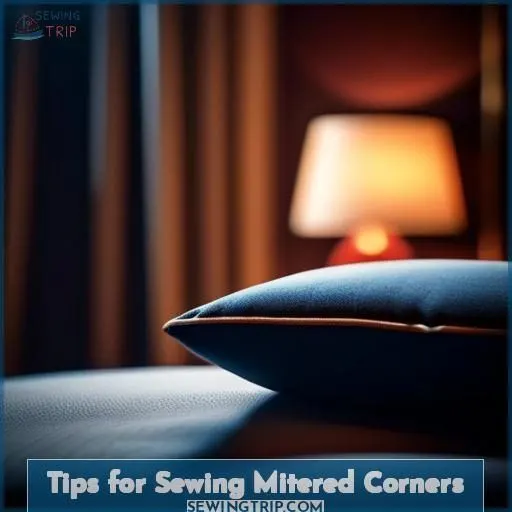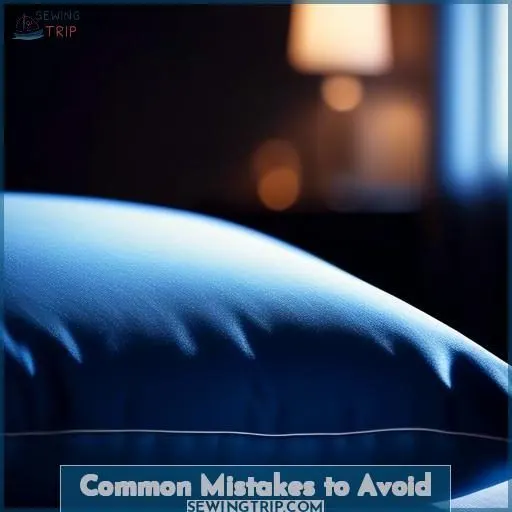This site is supported by our readers. We may earn a commission, at no cost to you, if you purchase through links.
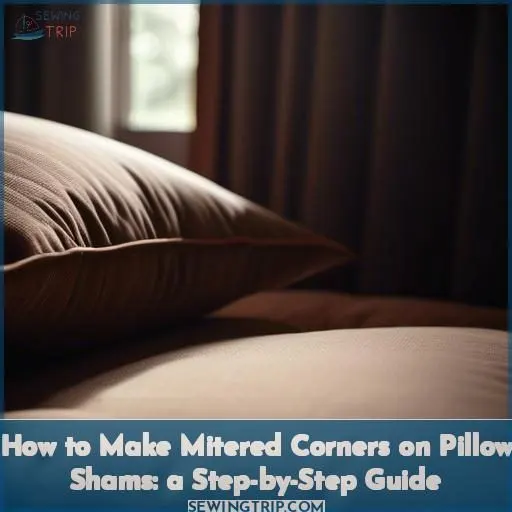
To make a mitered corner on a pillow, start by measuring and cutting the fabric to the appropriate size. Iron the flange pieces along the seam line for a clean and professional appearance. Sew the seam edges for the back panels, fold and pin the flange pieces, and sew them to the front panel.
Fold and sew the front panel, align and sew the back panels, and press the seams open. To create the mitered corners, fold the fabric, press the fold, measure and mark the corners, sew the corners, trim the excess fabric, press the seams open, and iron the corners.
Tips for sewing mitered corners include using a ruler and chalk, sewing a test piece, pressing the folds before sewing, backstitching for extra security, and ironing the seams open. Common mistakes to avoid include not measuring accurately, not pressing the folds, not sewing straight across the line, not cutting the excess fabric, and not turning the corners inside out. By following these steps and tips, you can create beautiful mitered corners on your pillow shams.
Table Of Contents
Key Takeaways
- Measure and cut the fabric to the appropriate size.
- Iron the flange pieces along the seam line for a clean and professional appearance.
- Fold and pin the flange pieces, then sew them to the front panel.
- Fold and sew the front panel, align and sew the back panels, and press the seams open.
How Do You Make a Mitered Corner on a Pillow?
To make a mitered corner on a pillow, follow these steps:
- Fold the front panel over the flange edges, meeting them together perfectly.
- Place a ruler along the short side of the panel and mark a point where it intersects with the long side. Repeat this on the other side of the panel.
- Draw a diagonal line connecting the two marks, creating a triangle shape.
- Cut along the line, removing the excess fabric from both sides of the panel.
- Sew the two panels together, leaving a space for stuffing or inserting a pillow form.
- Trim the excess fabric in the corners before turning the pillow right side out.
- Use a tool with a point, such as a small ruler or a pen with its cap on, to push out the corners for sharp corners.
Remember to taper the corners before sewing the two pieces together to achieve attractive, 90-degree corners on your pillows.
What Are Mitered Corners?
Precise corners are the key to granting your pillow shams that polished, custom-made appearance. It’s all about exactitude and alignment, where two borders meet at an exact 45-degree angle, fabricating a tidy and pristine completion. Envision it as the fabric’s method of offering you a crisp salute.
Regardless if you’re an experienced seamstress or a novice with a needle, mastering the miter implies elevating your pillow shams from crafted at home to handmade with flair. So, let’s explore the realm of miter types, bias, and fabric finesse.
How to Create Mitered Corners on Pillow Shams
Creating mitered corners on pillow shams adds a polished look to your home decor projects. Follow these steps to measure, cut, and sew your fabric accurately for a crisp, professional finish.
Step 1: Measure and Cut the Fabric
To create mitered corners on your DIY pillow shams, follow these steps:
-
Measure and Cut the Fabric:
- Measure your pillow to determine the size of the fabric needed.
- Select the appropriate fabric, making sure it’s suitable for home decor and has a weight that’s suitable for the project.
- Cut the fabric into the required pieces, including one front panel, two back panels, four flanges, and four sides.
- Iron the four flange pieces lengthwise in half to prepare them for sewing.
-
Sew the Seam Edges:
- Sew the seam edge for the two back panels to create a neat finish.
-
Fold and Pin the Flange Pieces:
- Fold the front panel in half, matching the two flange edges.
- Place a ruler alongside the folded edge and draw a line on the top flange piece to mark the corner.
-
Sew the Flanges to the Front Panel:
- Pin the top flange piece to the front panel and repeat this process with all flange pieces.
- Sew the flanges to the front panel, aligning the raw edges.
-
Fold and Sew the Front Panel:
- Fold the front panel over, aligning the box sides to the seam of the front panel and flanges.
- Pin the front panel together and sew at the already sewn line.
-
Align and Sew the Back Panels:
- Lay out the two back panels and pin them where the two pieces of fabric overlap.
- Sew the back panels together, lining up the edges with the front panel and flanges.
Step 2: Iron the Flange Pieces
Ironing is an essential step in creating mitered corners on pillow shams. It helps to press the folds and creases, guaranteeing a clean and professional appearance. Here’s a step-by-step guide on how to iron the flange pieces:
- Fold the fabric: Begin by folding the fabric in half along the seam line. This will create a crease that will guide your iron.
- Press the fold: Use a hot iron to press the fold, applying enough pressure to create a sharp crease. Be sure to use the appropriate ironing temperature for your fabric.
- Iron the edges: Next, iron the edges of the fabric to remove any wrinkles or creases. This will help ensure a smooth finish for your mitered corners.
- Press the corners: To create the mitered corners, you’ll need to press the corners of the fabric. Fold the fabric diagonally, so that the right sides are together, and press the corner with your iron.
- Repeat for all pieces: Repeat these steps for all the flange pieces, making sure that they’re evenly pressed and creased.
Step 3: Sew the Seam Edges
To create mitered corners on pillow shams, you’ll need to sew the seam edges of the fabric. Here’s a step-by-step guide:
- Prepare your fabric: Measure and cut the fabric to the appropriate size for your pillow sham. For mitered corners, you’ll typically need two pieces of fabric for each corner, each cut at a 45-degree angle to form a 90-degree corner.
- Iron the fabric: Before sewing, press the fabric to remove any wrinkles or creases. This will guarantee a clean and smooth seam.
- Sew the seam edges: Align the raw edges of the two pieces of fabric and sew them together using a 1/2-inch seam allowance. Be sure to sew along the edge of the mitered corner, not the diagonal edge.
- Press the seams: After sewing, press the seams open with a hot iron. This will help to flatten the seam and create a clean, crisp corner.
- Trim excess fabric: If necessary, trim any excess fabric from the corner to make sure that it’s square and even.
- Repeat for all corners: Follow the same process for each mitered corner on your pillow sham.
Remember to use a ruler and chalk to mark your sewing lines, and consider sewing a test piece before working on your actual sham. Press the folds before sewing to guarantee accurate alignment, and backstitch for extra security. Finally, iron the seams open to maintain the mitered corner shape.
Step 4: Fold and Pin the Flange Pieces
To create mitered corners on your pillow shams, you’ll need to fold and pin the flange pieces. Here’s a step-by-step guide:
- Fold the Flange Pieces: Start by folding the flange pieces in half along the length of the fabric. This will create a crease that will guide your sewing later.
- Press the Folds: Use an iron to press the folded edges of the flange pieces. This will help the fabric hold its shape during sewing.
- Mark the Corners: Before sewing, mark the corners of the flange pieces. This will help you sew the corners correctly and will form the mitered joint.
- Sew the Corners: Sew along the folded edge of the flange pieces, starting at one corner and working your way around the piece. Be sure to stop at each corner and pivot your fabric so that the needle is always perpendicular to the seam.
- Trim the Excess Fabric: Once you’ve sewn all the way around the flange piece, trim any excess fabric from the corners. This will help the corners lay flat and look neat.
- Press the Seams Open: Use the iron to press the seams open, smoothing out any wrinkles or folds.
- Iron the Corners: Finally, use the iron to press the corners of the flange pieces, making sure they’re crisp and well-defined.
Step 5: Sew the Flanges to the Front Panel
Now, sew those flanges to the front panel, ensuring pinning accuracy and the right seam allowance to avoid any unwanted fabric gathering.
| Needle Size | Thread Tension |
|---|---|
| Small | Low |
| Medium | Medium |
| Large | High |
| Just Right | Perfect |
| Too Big | Loopy |
Step 6: Fold and Sew the Front Panel
To create mitered corners on pillow shams, follow these steps:
Step 1: Fold the fabric
Fold the fabric in half along the diagonal line, with the wrong sides facing each other. Press the fold to create a sharp crease.
Step 2: Press the fold
Use an iron to press the fold, making sure to press the crease along the diagonal line. This will create a sharp, pointed corner.
Step 3: Measure and mark the corners
Measure 1/4 inch (0.635 cm) beneath the diagonal fold line and mark the corners with a fabric marker or pin.
Step 4: Sew the corners
Sew along the marked line, using a 1/4 inch (0.635 cm) seam allowance. Be sure to backstitch at the start and finish of the seam for added security.
Step 5: Trim the excess fabric
Trim the excess fabric along the seam allowance, leaving a 1/8 inch (0.3175 cm) seam allowance.
Step 6: Press the seams open
Press the seams open with an iron, making sure to press the corners flat and smooth.
Step 7: Iron the corners
Iron the corners to make sure they’re crisp and sharp. This will give your pillow shams a professional, clean look.
When sewing mitered corners, use a ruler and chalk to mark the lines, and sew a test piece before starting on your project. Press the folds before sewing to make sure they’re even and accurate. Backstitch the corners for added security, and iron the seams open to prevent bulk. Avoid common mistakes such as not measuring accurately, not pressing the folds, not sewing straight across the line, not cutting the excess fabric, and not turning the corners inside out.
Mitered corners can be used on various projects, including pillows, curtains, home decor, clothing, and accessories. They add a polished, professional look to any project, making them a popular choice for sewers of all skill levels.
Step 7: Align and Sew the Back Panels
Creating a mitered corner on a pillow sham involves several steps. First, you need to fold the fabric over the front panel, meeting together the two flange edges perfectly. Pin the edges together and sew along the line from top to bottom, not sewing into the front panel. Trim the excess fabric and cut the top of the mitered corner at a diagonal so that the seam edge doesn’t show. Open and lay flat to check the accuracy of your mitered corner, then repeat these steps for the remaining corners.
To align and sew the back panels, follow these steps:
- Lay out the two back panels, ensuring they measure the same length as the front panel.
- Pin and sew where the two pieces of fabric overlap.
- Align the box sides to the seam of the front panel and flanges, pinning them together.
- Sew at the already sewn line, leaving a 1/4 inch seam allowance.
- Complete sewing all sides with the wrong sides out.
- Pin the other edge of the box sides to the two pieces of the back panel, pinning them together.
- Sew the overlapping edges together, creating a seam.
Creating the Mitered Corners
To create mitered corners on your pillow shams, start by folding the fabric and pressing the fold. Then, measure and mark the corners before sewing them together.
Step 1: Fold the Fabric
To create mitered corners on pillow shams, you’ll need to fold the fabric in a specific way. First, fold the vertical fabric edge (lengthwise) down the seamline towards the wrong side of the fabric, then iron to crease along the seamline.
Next, fold the horizontal (crosswise) edge intersecting the corner, which usually corresponds to the hem, and open the folded edge to expose the fold line.
Then, fold the fabric corner in diagonally towards the wrong side of the fabric such that the inner crease corner intersects this. After folding, open the folded corner to expose the freshly-formed diagonal crease line.
Finally, insert pins to secure the corner in this folded position and stitch the folded corner directly on top of the diagonal crease mark until you arrive at the corner fold.
Step 2: Press the Fold
After folding the fabric, it’s time to set the fold. This step is essential for creating sharp mitered corners. Here’s how to do it:
- Set the fold using the appropriate pressing techniques for your fabric and seam allowance.
- Make sure the fold is crisp and precise to keep corner precision.
- Use pressing tools like a tailor’s ham or pressing board to help shape the corners.
- Remember, the better the fold, the better the final result will be.
Step 3: Measure and Mark the Corners
To create mitered corners on pillow shams, follow these steps:
- Fold the fabric corner diagonally towards the right side of the fabric, aligning the vertical and horizontal seamlines at the intersection point.
- Iron the fold to crease a defined line across the corner.
- Mark the crease with chalk or a fabric pencil, making sure that the fold lines are evenly spaced.
- Trim excess fabric about 1/4 away from the stitch line to release tension and allow the finished edge to lay flat.
- Iron the trimmed seam allowance open to prepare for sewing.
- Turn the finished corner on its right side to enclose all raw edges.
- Arrange the diagonal seam based on the seam allowance along each lengthwise edge.
- Iron one more time to give the finished edges a clean, defined look.
Remember to backstitch on both ends of the stitching to make sure the mitered corner doesn’t come undone.
Step 4: Sew the Corners
To sew the mitered corners on your pillow shams, you’ll need to select the right fabric, set your sewing machine appropriately, and choose the appropriate thread type. You’ll also need to set your iron to the right temperature.
Once you’ve prepared your materials, you can start sewing along the marked lines, ensuring that you sew straight and accurately. Remember to backstitch for extra security.
After finishing the sewing, press the seams open.
Step 5: Trim the Excess Fabric
To create mitered corners on pillow shams, follow these steps:
- Fold the Fabric: Fold the fabric corner diagonally towards the right side of the fabric, as shown in the diagram. The point where the vertical and horizontal seamlines intersect determines how far in the fold should be.
- Iron the Fold: Iron the fold to crease a defined line. This will serve as a guide for creating the mitered corner.
- Measure and Mark the Corners: Using a ruler and chalk, mark the corners to guarantee accurate placement.
- Sew the Corners: Sew along the stitching line to create the corner seam, backstitching at both ends for extra security.
- Trim the Excess Fabric: Trim the excess fabric, leaving ¼ inch. This will help to remove bulk and create a cleaner appearance.
- Press the Seams Open: Press the seams open to guarantee the corner lies flat.
- Iron the Corners: Iron the corners to guarantee they’re crisp and well-defined.
Remember to practice first and use a test piece to get familiar with the technique before working on your pillow shams.
Step 6: Press the Seams Open
To press seams open, you’ll need a hot iron set at the appropriate temperature for your fabric, an ironing board, and a pressing cloth if your fabric is prone to shine or if you want to protect it from the iron. Start by pressing the seam flat to remove any tiny puckers and set your stitches.
Gently open the seam with your fingers and finger press it open without pulling or stretching it. Use the tip of your iron to start opening the seam, then finish with the flat of your iron to press the seam fully open and flat.
Remember to press from the wrong side first, then turn the fabric and press from the right side.
Step 7: Iron the Corners
To create mitered corners on pillow shams, follow these steps:
- Fold the Fabric: Fold the fabric along the corner, making sure the raw edges align.
- Press the Fold: Use an iron to press the fold, creating a sharp crease.
- Measure and Mark the Corners: Measure 1/4 inch (0.635 cm) from the diagonal fold line and mark the corners with a fabric marker.
- Sew the Corners: Sew along the marked line, starting from the corner and moving in the direction of the edge.
- Trim the Excess Fabric: Trim the excess fabric close to the stitching line, but not through it.
- Press the Seams Open: Flatten the corner by pressing the seams open and giving it a neat appearance.
- Iron the Corners: Iron the corners to sharpen and smooth them.
Remember to use a ruler and chalk to mark the corners with precision. Before working on the actual pillow sham, practice your technique by sewing a test piece first. To avoid bulk and achieve a clean finish, press the folds before sewing. For added security, backstitch at the start and end of the seam. To prevent bulk and to ensure the corners lie flat, press the seams open.
Tips for Sewing Mitered Corners
To make mitered corners on pillow shams, follow these tips:
- Use a ruler and chalk to mark the corners precisely.
- Sew a test piece to practice the technique and make sure you’re confident with the process.
- Press the folds before sewing to create a sharp corner.
- Backstitch for added security to prevent the corner from unraveling or breaking apart.
- Iron the seams open to prevent bulk and ensure a polished finish.
By following these tips, you can create beautiful, mitered corners on your pillow shams that will add a professional touch to your décor.
Use a Ruler and Chalk
Use a ruler and chalk to mark the folding technique precisely. Accurate markings guarantee perfect seam allowance. Pressing the folds is crucial before sewing by hand or machine for a polished finish.
Sew a Test Piece
After marking with chalk, it’s imperative to practice-sew on spare fabric. This guarantees your seam allowance is flawless and your ironing method perfects that mitered angle precision, preventing any sewing-related blunders.
Press the Folds Before Sewing
Preparing the folds prior to sewing is a vital step in achieving mitered corners. This technique guarantees that the creases are precise and the seam alignment is accurate, which is essential for the quality of the final product. Here are some guidelines on how to prepare the folds before sewing:
- Use a Ruler and Chalk: Before ironing, mark the folds using a ruler and chalk. This will help you maintain a consistent and accurate crease.
- Press with the Appropriate Pressure: Adjust the presser foot pressure on your sewing machine to make sure that the fabric feeds smoothly under the foot. Excessive pressure can cause the fabric to stretch, while insufficient pressure may cause it to slide around.
- Use the Correct Heat Setting: Set your iron to the appropriate heat setting for the fabric you’re working with. Different fabrics require different heat settings to avoid damaging or melting them.
- Use a Pressing Cloth: If you’re working with delicate fabrics, use a pressing cloth to protect them from the heat of the iron.
- Press from the Reverse Side: When possible, press the folds from the back of the fabric to avoid pressing creases into the right side of the fabric.
- Press Seams Open: Press seams open or to one side to make the stitching easier and create a smooth, flat seam.
- Press Sleeves and Small Areas: Use a pointed end of the ironing board or a sleeve board to press sleeves and other small, hard-to-reach areas.
Backstitch for Extra Security
Backstitching is a sewing technique that involves stitching over the same area twice to create a stronger and more secure seam. It’s particularly useful when sewing mitered corners, as it helps to reinforce the corners and prevent them from unraveling over time. Here are some tips for using backstitch when sewing mitered corners:
- Choose the right thread: Use a thread that matches the color of your fabric to make sure a neat and invisible seam.
- Select the appropriate needle size: Choose a needle size that’s appropriate for your fabric thickness. A larger needle can help to push through thicker fabrics, while a smaller needle is better for lighter fabrics.
- Use a consistent stitch length: Maintain a consistent stitch length throughout your project to guarantee even stitching and a neat finish.
- Stitch slowly and evenly: Take your time when sewing mitered corners, as rushing can lead to uneven stitching and potential errors.
- Backstitch at the corners: When sewing mitered corners, backstitch at the corners to reinforce the seam and prevent the corners from fraying or unraveling.
Iron the Seams Open
To create mitered corners on pillow shams, it’s vital to iron the seams open. Ironing techniques play a key role in achieving accurate and neat corners. Here’s how to do it:
- Flatten the Seams: After stitching the corner seams, flatten them open with a hot iron. This step helps to remove any extra fabric and makes sure that the corners are flat and smooth.
- Use a Press Cloth: To safeguard the fabric from heat damage, place a press cloth over the corner before ironing. This will also help to prevent any unwanted creases or wrinkles.
- Iron the Corners: Carefully iron the corners of the pillow sham, making sure to flatten the seams open and not fold them. This will help to maintain the sharpness of the mitered corners.
- Check for Accuracy: After ironing, check the corners for any inconsistencies or misalignments. If needed, adjust the corners by re-sewing or flattening them again until they’re perfectly aligned.
Common Mistakes to Avoid
Common mistakes to avoid when making mitered corners on pillow shams include:
Not measuring accurately
Not pressing the folds
Not sewing straight across the line
Not cutting the excess fabric
Not turning the corners inside out
To guarantee success, it is essential to:
Measure accurately
Press the folds
Sew straight across the line
Cut the excess fabric
Turn the corners inside out
Not Measuring Accurately
Not measuring accurately is a common mistake when creating mitered corners on pillow shams. To avoid this, guarantee precision cutting and pay attention to detail, including seam allowances. Here are four tips to help you measure accurately:
- Use a ruler and chalk to mark your measurements.
- Sew a test piece before cutting your fabric.
- Press the folds before sewing to guarantee accurate measurements.
- Backstitch for extra security when sewing the corners.
Not Pressing the Folds
Not pressing the folds can lead to wrinkles and inaccurate measurements. Use an iron to press the folds before sewing, ensuring seam strength and preventing potential issues. Always iron trial fabric first to test heat settings and avoid damaging the main fabric.
Not Sewing Straight Across the Line
Not sewing straight across the line is a common mistake when creating mitered corners on pillow shams. This can lead to inaccurate seams and uneven corners. To make sure seaming is accurate, measure precisely, align the fabric correctly, and use seam allowances. Pressing techniques can also help maintain fabric alignment and improve the overall appearance of the corners.
Not Cutting the Excess Fabric
Ignoring excess fabric is a typical error in sewing mitered corners. It’s essential to measure precisely and flatten the folds before sewing to guarantee straight, level corners. Here’s how to prevent this mistake:
- Measure Precisely: Before cutting the fabric, verify that you have measured the correct dimensions for your mitered corners. This will help you avoid cutting too much or too little fabric.
- Flatten the Folds: After folding the fabric, flatten the folds to create a defined crease. This will act as a guide when sewing the mitered corners.
- Sew Straight: When sewing the mitered corners, sew along the crease you flattened earlier. This will help ensure that the corners are sewn at the correct angle.
- Trim Excess: After sewing the corners, trim any excess fabric that extends beyond the mitered edge. This will help prevent bulk and ensure that the corners lie flat.
- Turn Corners Inside Out: Finally, turn the corners inside out to reveal the cleanly finished mitered edge. This will give your pillow shams a professional look.
Not Turning the Corners Inside Out
Turning corners inside out is essential for mitered edges. Here’s why:
- Fabric Thickness: Turning the corners inside out helps to align the mitered edges properly, ensuring that the thickness of the fabric is consistent.
- Seam Allowance: It allows you to press the seam allowance flat, which is necessary for a clean and neat look.
- Avoiding Puckering: By turning the corners inside out, you can avoid puckering, which can occur when the mitered edges aren’t aligned correctly.
Frequently Asked Questions (FAQs)
How do I create a mitered corner on a pillow sham?
To create a mitered corner on a pillow sham, you’ll need to fold the fabric over to meet the two flange edges perfectly. This can be done by folding the front panel along the edge where the flanges meet, and then pressing and pinning the folds together. After sewing the flanges to the front panel, you’ll fold the front panel back over the flanges, creating a clean, mitered corner look.
What tools do I need to make mitered corners on pillow shams?
To craft mitered corners on pillow shams, you’ll need a ruler, fabric marker, scissors, and a sewing machine. Precision is key, so measure twice, cut once, and sew with confidence.
How do I measure for mitered corners on pillow shams?
To measure for mitered corners on pillow shams, you need to factor in the size of your pillow and the desired width of the mitered border. Here’s a step-by-step guide:
- Measure the pillow: Determine the exact dimensions of your pillow, including its width, height, and depth.
- Decide on the border width: Choose the width of the mitered border you want to add to your pillow sham. This could be 1 inch, 2 inches, or any other desired measurement.
- Calculate the total border width: To find the total width of the mitered border, multiply the border width by For example, if you want a 1-inch border, the total width would be 2 inches.
- Measure and mark the corners: Lay out the fabric for your pillow sham and measure and mark the corners where the mitered borders will meet. Use a ruler or fabric measuring tape to find the spot on the fabric that’s 25 to 5 inches from the edge.
- Draw a line between the marks: Once you have marked the corners, draw a line between the marks at each corner to indicate where the mitered corners will be sewn.
- Fold and press the corners: Fold the corners in half so the marks line up and press them with an iron to create a crease in the fabric.
- Sew the mitered corners: Set your sewing machine to the straight stitch setting and sew straight across the lines you have drawn onto the fabric. Sew right off the edge when you get to the end.
- Trim excess fabric: After sewing the mitered corners, turn the corners inside out and iron them to flatten the seams. If necessary, trim any excess fabric to guarantee a neat and clean appearance.
Remember to prewash and tumble dry your fabric before starting your project to avoid shrinkage. Additionally, use a ruler or fabric measuring tape to ensure accurate measurements and a professional finish.
What is the best fabric to use for mitered corners on pillow shams?
Ever wondered why your grandma’s linen closet smells of victory? It’s because cotton and linen fabrics, with their crisp edges, are the champions for mitered corners on pillow shams. They fold like a dream!
Can I use a different method to create mitered corners on pillow shams?
To make a mitered corner on a pillow sham, you can use a different method. Instead of the traditional mitered corners where two pieces of fabric meet with their joint on an angle, you can try a tapered corner. This method involves cutting the fabric at a 45-degree angle and sewing it together to create a clean, sharp corner.
Start by measuring and cutting the fabric for the front panel, back panels, flanges, and sides of the pillow sham. Iron the flange pieces lengthwise in half and sew the seam edge for the back panels. Pin the top flange piece to the front panel and repeat with all flange pieces. Sew the flanges to the front panel, fold over the front panel to meet together the two flange edges, and draw a line on the top flange piece.
Lay out the two back panels and pin and sew where the two pieces of fabric overlap. Align the box sides to the seam of the front panel and flanges, pin together, and sew at the already sewn line. Finally, press the seams open and trim excess thread.
Conclusion
Creating mitered corners on pillow shams can be a challenging task, but with the right steps and techniques, you can achieve a professional and polished look. By following the guide provided, you’ll learn how to measure and cut the fabric, iron the flange pieces, sew the seam edges, fold and pin the flange pieces, and sew the flanges to the front panel.
Additionally, you’ll discover tips for sewing mitered corners, such as using a ruler and chalk, pressing the folds before sewing, and backstitching for extra security. Remember to avoid common mistakes like not measuring accurately, not pressing the folds, and not turning the corners inside out.
With practice and patience, you’ll be able to create beautiful mitered corners on your pillow shams.

